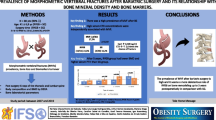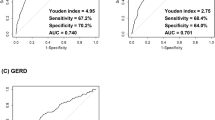Abstract:
We examined the relationship between the presence of esophageal hiatal hernia (HH) assessed by endoscopy and the presence of vertebral fractures (VFs) in 87 Japanese postmenopausal women (age range 52–87 years). We found that 29 (63%) of 46 patients with HH (71.2 ± 6.1 years, mean ± SD) had one or more VFs, compared with 14 (34%) of 41 patients without HH (70.8 ± 6.8 years), which was a significant difference in the frequency of VFs (c2= 7.242; p= 0.0071). The average number of VFs per patient was significantly higher for the patients with HH than for those without HH (1.67 ± 1.75 vs 0.68 ± 1.21, p= 0.0032). There were no significant differences in absolute or age-matched bone mineral density (BMD) values at the lumbar spine (0.656 ± 0.131 vs 0.662 ± 0.148 g/cm2; Z-score, –0.35 ± 1.17 vs –0.26 ± 1.00) and there were no significant differences in biochemical parameters, age, years since menopause or body mass index (BMI) between the two groups. When patients were divided into those with reflux esophagitis (RE) (n= 30, 70.2 ± 7.3 years) and those without RE (n= 57, 71.4 ± 5.9 years), no significant differences were detected in any of the above parameters including the presence or number of VFs. The patients were further subdivided into four groups: those with ‘HH only’ (n= 23, 72.3 ± 4.6 years), with ‘RE only’ (n= 7, 70.9 ± 7.7 years), with ‘both’ (n= 23, 70.0 ± 7.3 years) and with ‘neither’ (n= 34, 70.8 ± 6.7 years). One or more VFs were found in 12 (52%), 1 (14%), 17 (74%), and 13 (38%) patients in each group, respectively, and the difference in frequency was significant (c2= 10.748; p= 0.0132). The average number of VFs per patient in each group was 1.57 ± 2.06, 0.14 ± 0.38, 1.78 ± 1.41 and 0.79 ± 1.30, respectively, and there were significant differences between the ‘both’ and ‘neither’ groups, and between the ‘both’ and ‘RE only’ groups (p<0.05). When univariate logistic regression analysis was performed with the presence of HH as a dependent variable and each of the presence of VFs, the number of VFs per patient, absolute or age-matched BMD values at the lumbar spine, BMI and plasma albumin as independent variables, the presence of VFs and the number of VFs per patient were selected as indices affecting the presence of HH (odds ratio: 3.29 and 1.59, 95% confidence interval: 1.36–7.94 and 1.14–2.23; p = 0.0080 and 0.0064, respectively). These results show that the presence and severity of VFs are associated with the presence of HH but not of RE in Japanese postmenopausal women, and suggest that kyphosis induced by multiple VFs might predispose elderly women to a complication with HH.
Similar content being viewed by others
Author information
Authors and Affiliations
Additional information
Received: 2 March 2001 / Accepted: 11 June 2001
Rights and permissions
About this article
Cite this article
Yamaguchi, T., Sugimoto, T., Yamada, H. et al. The Presence and Severity of Vertebral Fractures is Associated with the Presence of Esophageal Hiatal Hernia in Postmenopausal Women . Osteoporos Int 13, 331–336 (2002). https://doi.org/10.1007/s001980200034
Published:
Issue Date:
DOI: https://doi.org/10.1007/s001980200034




